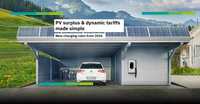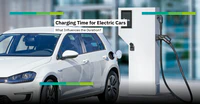Whoever charges their company car at home and wants to have the costs reimbursed by the employer tax-free must correctly account for the electricity consumption. Until the end of 2025, the legally permitted flat rate was a simple solution – but it rarely covered the actual costs. From 2026, this option will no longer exist. Companies and employees must now choose one of the two permissible methods: exact billing or electricity price flat rate. Both require reliable documentation and suitable technical equipment.
Update 2026: Flat rates abolished in Germany
Until the end of 2025, companies could choose between a flat rate and exact billing. From 2026, flat rates will be completely abolished.
Instead, there are two permissible methods for EV charging reimbursement:
Actual costs: Proof via electricity tariff and charged kWh
Electricity price flat rate: Based on Destatis data, e.g., approx. €0.34/kWh for 2026 and charged kWh
The proof requirement remains: The charged electricity must be documented via a separate meter or the vehicle’s internal meter.
Find all details about the changes in this blog post: EV Charging Reimbursement from 2026 .
Overview of the Three Billing Methods
Flat Rate Billing
The company pays a fixed monthly amount, regardless of actual electricity consumption. In Germany the amount depends on the vehicle type and whether charging is available at the workplace.
| Vehicle Type | Workplace Charging | Monthly Flat Rate |
|---|---|---|
| Electric Car | No | € 70 |
| Electric Car | Yes | € 30 |
| Plug-in Hybrid | No | € 35 |
| Plug-in Hybrid | Yes | E 15 |
Advantages
Tax-free under § 3 No. 50 EStG
No measurement effort
Low administrative burden
Disadvantages
Lack of transparency
Actual electricity costs often higher
No control over charging behavior
Manual Billing Based on Consumption
Electricity consumption is recorded via a separate MID-certified meter . Employees regularly read the meter and submit the data for reimbursement.
Requirements
Meter exclusively records company car usage
Meter reading is always visible and accessible
No other consumers connected to the meter
Disadvantages
Prone to errors
High effort
Not legally compliant for shared charging setups
Automated Billing
Charging sessions are digitally recorded and transmitted directly to the company, e.g., via the Charge Repay Service.
Advantages
Convenient and audit-proof
Legally compliant even with multiple users
No manual documentation required
Separation of private and business charging via a web application
Technical Basis
MID meter with communication interface
Web application for management
Retrofit possible regardless of manufacturer
Technical Requirements for Accurate Billing
To ensure legally compliant billing, specific technical standards must be met. A legally compliant charging station or appropriate retrofit is required.
Compliant with MessEG and MessEV
Cryptographically secured measurement data
Interfaces to billing systems
Suitable for third-party billing
Alternative: The Charge Repay Service enables retrofitting of existing charging stations. The solution is manufacturer-independent.
Decision Support for Companies
|Method|Effort| Legal Compliance|Cost|
| Recommended For | ||||
|---|---|---|---|---|
| Flat Rate Billing | Low | Medium | Low | Small fleets, simple cases |
| Manual Billing | High | Limited | Low | Individuals with separate meters |
| Automated Billing | Medium | High | Medium | SMEs, multiple users, sustainability |
Conclusion: Legally Compliant Billing with Minimal Effort
The appropriate billing method depends on various factors, including fleet size, technical setup, tax regulations, and usage behavior. Those looking to reduce effort while ensuring legal compliance will find a flexible solution in the Charge Repay Service. Retrofitting is also possible for existing charging stations.




